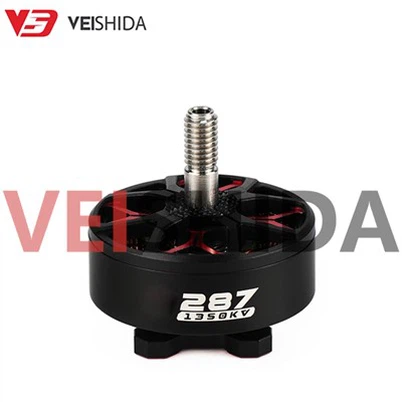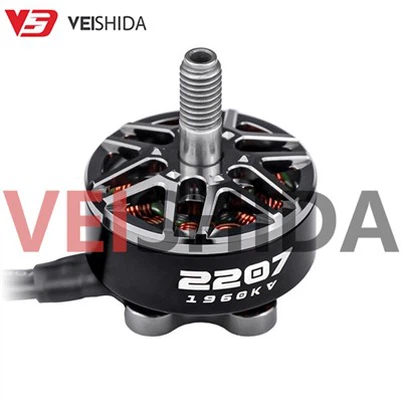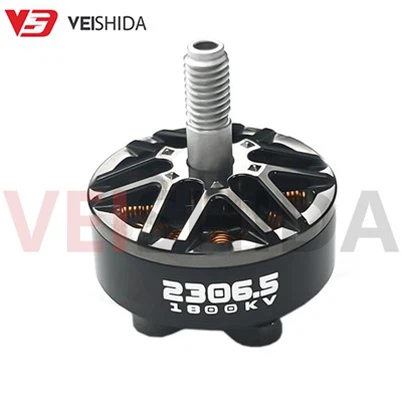What types of drone motors are there? A comprehensive analysis from structure to use
Leave a message
Choosing the right motor type is more important than you think
In the previous article, we have figured out the working principle of drone motors and why brushless DC motors have become mainstream. If you still don't know "Is the drone motor DC or AC?", it is recommended to read the previous article first, which will help you better understand the following key points: "Why different flight missions require different types of motors"
There are many types of drone motors on the market, ranging from 2207 to 5315, from 2400kv to 380kv. Different parameters mean completely different design logic and flight performance.
This article will give you a comprehensive understanding of the main types of drone motors from the three dimensions of structure, purpose, and performance, and combine the actual parameters of VSD drone motors to help you make a more accurate selection judgment.

Motor Types by Structure
Drone motors can be divided into two categories according to their structure and working principle:
Brushed Motor
The brushed motor is the earliest widely used type of motor. Its structure contains carbon brushes and a commutator, which mechanically switches the direction of the current to make the rotor rotate.
Features:
Simple structure and low cost;
The driving circuit is simple and can be powered directly;
Due to the friction between the carbon brush and the commutator, the service life is short and maintenance is frequent;
It is noisy when running and has relatively low efficiency;
Suitable for toy or entry-level small drones with limited performance.
With the advancement of technology, the share of brushed motors in the professional drone market has gradually been replaced by brushless motors.
Brushless Motor
The brushless motor eliminates the mechanical commutation part and uses an electronic commutator (ESC) for current switching, which improves efficiency and life. Brushless motors are divided into two types according to the rotor structure:
a. Inrunner brushless motor
The rotor is inside the motor and the stator is outside;
The rotor has a high speed and is relatively small in size;
Suitable for small UAVs and some high-speed applications.
b. Outrunner
The rotor is wrapped around the stator and is usually larger in size;
The speed is relatively low, but the output torque is large;
Due to the outer rotor structure, the heat dissipation is better and it is suitable for drones such as aerial photography and multi-rotor drones that require high stability.

The "role positioning" of drone motors: divided into four categories according to flight requirements
Before choosing a motor, you must understand that drone motors are not "universal parts" but rather mission-specific components. Different flight missions have very different requirements for motor thrust, response speed, endurance, stability and other indicators.
We can categorize the "duties" of drone motors into four main categories:
1. Racing drones
Mission scenarios: racing, flying across the sky, freestyle flying
Motor features:
High KV value (1800~2500KV)
Small diameter propeller (mainly 5 inches)
The instantaneous current is large and the speed changes quickly
The motor is light and has low inertia
Goal: To reach top speed and perform intense movements in a very short time.
2. Stabilized drone for aerial photography
Mission scenarios: aerial photography, 3D modeling, automatic mapping
Motor features:
Medium KV value (900~1500KV)
Medium blades (6-9 inches)
Stable speed and low noise
Strong compatibility with the PTZ anti-seismic structure
Goal: Provide continuous and balanced thrust to ensure stable picture and track.
3. Industrial-grade payload drone
Mission scenarios: agricultural spraying, logistics transportation, material lifting
Motor features:
Low KV value (300~600KV)
High voltage platform (8S~12S)
Can be equipped with large diameter high pitch propeller blades (over 13 inches)
Heat dissipation and structural strength are given priority in design
The goal: to efficiently carry heavy loads and maintain performance over long periods of time.
4. Educational/DIY/Multi-purpose UAV
Task scenarios: teaching courses, prototype verification, open source development
Motor features:
Medium KV value (1100~1500KV)
Easy to install, flexible size
Compatible with a variety of propellers, ESCs and flight control platforms
Goal: Get started quickly, low risk, and adaptable to multiple combinations and experimental scenarios.

Common Model Introduction and KV Value Reference
In the field of drone motors, the three factors of "model + KV value + voltage" determine the core performance of the power system. Through them, you can preliminarily judge which aircraft the motor is suitable for, whether it is for racing, aerial photography or load transportation.
Below, we take VSD's self-developed drone motor series as an example, combined with real test data, to show the typical parameter range and application positioning:
|
Motor Model |
KV value range |
Recommended voltage (S) |
Maximum power (W) |
Maximum thrust (g) |
Application |
|
380KV |
6S ~ 12S |
4257W |
9034g |
Industrial grade load-carrying drone |
|
|
420KV |
6S ~ 8S |
3037W |
7232g |
Medium and large surveying and mapping platform |
|
|
900 / 1050 / 1520KV |
5S ~ 8S |
1617W |
4185g |
Aerial photography multi-rotor platform |
|
|
1300 / 1500 / 1950KV |
6S |
1623.5W |
2910.4g |
Compatible with aerial photography or racing |
|
|
900KV |
6S |
1010W |
2710g |
Stabilized aerial photography drone |
|
|
1350 / 1750KV |
4S ~ 6S |
1436W |
2728.4g |
Multi-purpose flying platform |
|
|
1800 / 1960 / 2400KV |
4S ~ 6S |
901W |
1683g |
FPV Racing Drone |
|
|
1960KV |
6S |
902.5W |
1702.7g |
Speed cross & Freestyle |
How to choose KV value?
KV (RPM/V) indicates the speed generated by the motor per volt of voltage. Common selection ideas are as follows:
High KV (above 1800): suitable for high-speed rotation of small paddles, fast response, suitable for racing and crossing.
Medium KV (1000–1500): Balances thrust and endurance, suitable for stable flight such as aerial photography and surveying.
Low KV (below 600): drives large propellers with high torque, suitable for load-bearing and long-range scenarios.
Note: A higher KV value does not mean a stronger thrust. It needs to be comprehensively matched with the blade specifications, voltage platform and current output capacity.

Motor selection strategy: Decision-making process based on flight goals
With so many drone motor models, novices are often confused: How many KV should I choose? How much thrust? How many S batteries should I use? How to match the propellers?
Don't worry, this section will use a simple and practical thinking path to guide you to derive the appropriate motor solution step by step from flight requirements. The idea is as follows:
Step 1: Determine the "full weight" and "purpose" of the aircraft
"The first step in selecting a thrust motor is to know what you are going to lift and what it is used for."
Total weight = battery + flight controller + motor + frame + gimbal/payload
Example:
FPV drone≈ 400~600g
Aerial photography multi-rotor ≈ 2~4kg
Industrial drones ≈ 5~10kg+
Step 2: Calculate target thrust ➜ thrust-to-weight ratio ≥ 2:1
"The total thrust of your motors must be at least twice the weight of the entire machine."
Assume the weight of the whole machine is 3kg
Total thrust target: 3kg × 2 = 6kg
If it is a four-axis machine, each motor must output ≥ 1500g thrust
Step 3: Select KV value (combining propeller blades and voltage platform)
"KV is not the higher the better. It should match your propeller size and battery voltage."
Tips:
KV value × voltage × magnetic field constant ≈ no-load speed ➜ If your propeller is large and the voltage is high, the KV value cannot be too high.
Step 4: Refer to the motor parameter table to find the matching items
Compare the motor specification sheets provided by the manufacturer to find models that meet the following criteria:
Thrust ≥ your target value
Voltage support range matches battery platform
Size & mounting holes to suit your flight structure
Heat dissipation/material/cable quality meets the requirements of long-term flight
Step 5: Give a practical example
Task: You plan to design a quadcopter drone for aerial photography. The weight of the drone is 3.2kg. The battery is 6S 22.2V and it is equipped with 9-inch propellers.
Selection process:
Thrust-to-weight ratio target = 3.2kg × 2 = 6.4kg ➜ Each motor ≈ 1600g
Voltage = 6S, Propeller = 9 inches ➜ Recommended KV ≈ 900~1100KV
Looking up the parameter table, I found:
VSD 3115 (900KV)
Recommended voltage: 6S~8S, maximum thrust: 4185g ➜ Far beyond the target
Moderate size, suitable for 9-inch propellers, compatible with 6S platform
This completes the selection!

Choose the right motor to make flight more efficient and stable
The motor is not just a "power source" that makes the propeller turn, it determines the flight quality, efficiency and safety margin of the drone. Starting from the starting point of the flight mission, you need to understand the matching logic of the motor structure, KV value, voltage and blades to select the power system that is truly suitable for your project.
In terms of motor manufacturing, VSD focuses on the design, production and optimization of brushless drone motors, and its services cover a variety of drone scenarios including aerial photography, racing, industry, agriculture, etc. We have complete R&D capabilities and quality control systems, and can provide full-process support from standard models to customized development.
We offer:
Brushless motor products with various KV, voltage and size specifications;
System matching suggestions for motor + ESC + propeller;
Real thrust test data, CAD drawings and technical parameter support;
OEM / ODM customized services to meet the personalized needs of different applications.
If you are looking for high-performance, stable and reliable drone motors, please contact our engineering team. We are willing to work with you to make the flight experience farther, more stable and safer.








